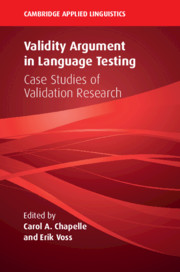Book contents
- Validity Argument in Language Testing
- The Cambridge Applied Linguistics Series
- Validity Argument in Language Testing
- Copyright page
- Contents
- Figures
- Tables
- Contributors
- Series Editor’s Preface
- 1 Introduction to Validity Argument in Language Testing and Assessment
- Part I Basic Concepts and Uses of Validity Argument in Language Testing and Assessment
- Part II Investigating Score Interpretations
- 4 Domain Definition Inference for a Virtual Interactive Aviation English Test (VIAET) for Military Air Traffic Controllers
- 5 Support for the Evaluation Inference
- 6 Generalization Inference for a Computer-Mediated Graphic-Prompt Writing Test for ESL Placement
- 7 The Telephone Standard Speaking Test
- 8 The Explanation Inference for a Test of Academic English Collocational Ability
- 9 Extrapolation of the Meaning of Grades on Writing Tasks in an ESL Writing Class to Success on Tasks in University Courses
- Part III Investigating Score Uses and Consequences
- Part IV Conclusion
- Index
- References
4 - Domain Definition Inference for a Virtual Interactive Aviation English Test (VIAET) for Military Air Traffic Controllers
from Part II - Investigating Score Interpretations
Published online by Cambridge University Press: 14 January 2021
- Validity Argument in Language Testing
- The Cambridge Applied Linguistics Series
- Validity Argument in Language Testing
- Copyright page
- Contents
- Figures
- Tables
- Contributors
- Series Editor’s Preface
- 1 Introduction to Validity Argument in Language Testing and Assessment
- Part I Basic Concepts and Uses of Validity Argument in Language Testing and Assessment
- Part II Investigating Score Interpretations
- 4 Domain Definition Inference for a Virtual Interactive Aviation English Test (VIAET) for Military Air Traffic Controllers
- 5 Support for the Evaluation Inference
- 6 Generalization Inference for a Computer-Mediated Graphic-Prompt Writing Test for ESL Placement
- 7 The Telephone Standard Speaking Test
- 8 The Explanation Inference for a Test of Academic English Collocational Ability
- 9 Extrapolation of the Meaning of Grades on Writing Tasks in an ESL Writing Class to Success on Tasks in University Courses
- Part III Investigating Score Uses and Consequences
- Part IV Conclusion
- Index
- References
Summary
This chapter reports creation of a prototype assessment using virtual simulation for a test intended to assist in decision-making for non-native English-speaking military air traffic controllers’ placement into appropriate work assignments and to provide them with diagnostic feedback. The research and development focused on the domain definition inference, whose warrant was that observations of performance on the virtual interactive tasks for aviation English assessment are representative of the knowledge, skills and abilities required of air traffic controllers in an Asian country. Evidence Centered Design (ECD) guided the domain analysis and methods from Task-Based Language Assessment (TBLA) were also used, including eliciting opinions of two domain experts, document analysis, and a survey of 71 participants in the domain. Results indicated good backing for the first two assumptions: (1) critical aviation English skills, knowledge, and processes needed for aviation English communication in the military ATC context can be identified and (2) assessment tasks that are representative of the English for Specific Purposes (ESP) domain of ATC can be modeled as assessment tasks. The third assumption, (3) assessment tasks that require important knowledge and skills for communication in aviation English can be simulated in Second Life, was only partially supported.
Keywords
- Type
- Chapter
- Information
- Validity Argument in Language TestingCase Studies of Validation Research, pp. 73 - 95Publisher: Cambridge University PressPrint publication year: 2021



